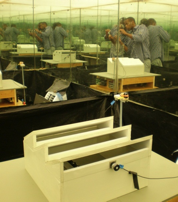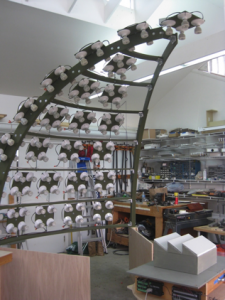1. Mirror-Box Artificial Sky
 A simple and low-cost mirror-box artificial sky was developed and installed at the Daylighting Research Site. The artificial sky has a brightness distribution that closely approximates to the standard overcast sky and provides a way of testing scale models both quantitatively, i.e. by Daylight Factor distribution, and qualitatively by direct observation and photography. A validation study was conducted to optimize the device so that it has a luminous distribution that closely approximates to the standard overcast sky and provides a way of testing scale models both quantitatively and qualitatively.
A simple and low-cost mirror-box artificial sky was developed and installed at the Daylighting Research Site. The artificial sky has a brightness distribution that closely approximates to the standard overcast sky and provides a way of testing scale models both quantitatively, i.e. by Daylight Factor distribution, and qualitatively by direct observation and photography. A validation study was conducted to optimize the device so that it has a luminous distribution that closely approximates to the standard overcast sky and provides a way of testing scale models both quantitatively and qualitatively.
2. 1/6 dome Scanning Sky Simulator for simulating all sky conditions.
 A 1/6-dome Scanning Sky Simulator was established and evaluated in this project as a Climate-Based Daylight Modeling tool for predicting daylight quantity in buildings on an annual basis. This method involves establishing sky luminance distribution as climate data input, testing physical models under the Scanning Sky Simulator as the simulation procedure, and calculating interior daylight quantity based on the concept of Daylight Coefficient as the underlying theory. As a physical simulation tool, the Scanning Sky Simulator is assessed by comparing the performance data acquired from testing two typical daylighting designs under the device with the data collected from monitoring the same designs under the real sky. The results show that the differences between the predicted daylight quantities by the simulator and the measured quantities under the real sky are within 10% in average for the two daylighting systems tested.
A 1/6-dome Scanning Sky Simulator was established and evaluated in this project as a Climate-Based Daylight Modeling tool for predicting daylight quantity in buildings on an annual basis. This method involves establishing sky luminance distribution as climate data input, testing physical models under the Scanning Sky Simulator as the simulation procedure, and calculating interior daylight quantity based on the concept of Daylight Coefficient as the underlying theory. As a physical simulation tool, the Scanning Sky Simulator is assessed by comparing the performance data acquired from testing two typical daylighting designs under the device with the data collected from monitoring the same designs under the real sky. The results show that the differences between the predicted daylight quantities by the simulator and the measured quantities under the real sky are within 10% in average for the two daylighting systems tested.
3. Coefficient of Utilization method for climate-based daylight modeling.
As a daylighting performance indicator, Coefficient of Utilization (CU – the ratio of interior illuminance to exterior vertical illuminance) is examined in this study in terms of its effectiveness in predicting daylight quantity in wall-based sidelighting designs. To validate this approach, CUs are developed for three exemplary daylighting models to establish the correlations between exterior daylight recourse data and interior illuminances. Exact copies of these three daylighting models are also monitored under the real sky simultaneously with the daylight recourse data being collected at the same time interval. By multiplying the collected exterior daylight recourses by the CUs, interior daylight quantities can be predicted. Comparisons are then made between the predicted and measured daylight quantities to validate this method. The results show that, compared to the traditional DF approach, the CU method significantly improves the accuracy of the daylight performance assessment for wall-based sidelighting systems.
